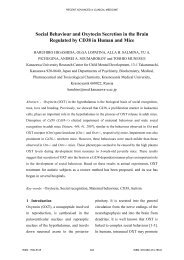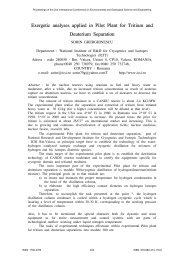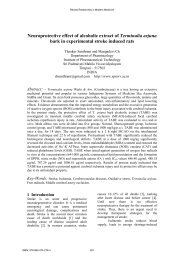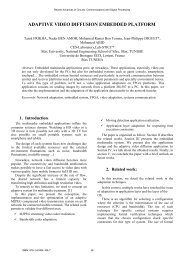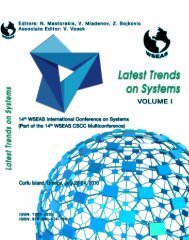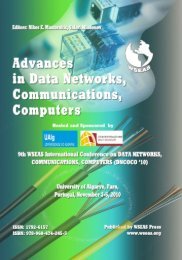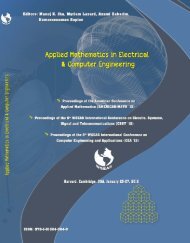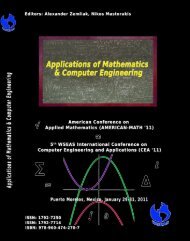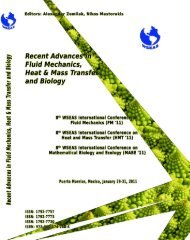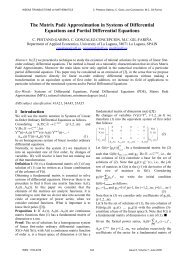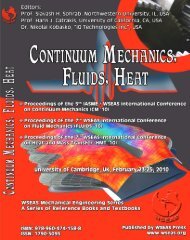Image Compression Approach using Segmentation and ... - Wseas.us
Image Compression Approach using Segmentation and ... - Wseas.us
Image Compression Approach using Segmentation and ... - Wseas.us
Create successful ePaper yourself
Turn your PDF publications into a flip-book with our unique Google optimized e-Paper software.
Recent Researches in Telecommunications, Informatics, Electronics <strong>and</strong> Signal ProcessingiCast: <strong>Image</strong> <strong>Compression</strong> <strong>Approach</strong> <strong><strong>us</strong>ing</strong> <strong>Segmentation</strong> <strong>and</strong> TotalVariation RegularizationAHMAD SHAHIN, FADI CHAKIK, WALID MOUDANIDoctoral School for Science <strong>and</strong> TechnologiesLebanese UniversityMitein Street, Face to Malaaba High School, TripoliLEBANON[ashahin, fchakik, wmoudani]@ul.edu.lb, http://edst.ul.edu.lbAbstract: - In this paper we present a hybrid model for image compression based on segmentation <strong>and</strong> totalvariation regularization. The main motivation behind our approach is to offer decode image with immediateaccess to objects/features of interest. We are targeting high quality decoded image in order to be <strong>us</strong>eful onsmart devices, for analysis purpose, as well as for multimedia content-based description st<strong>and</strong>ards. The image isapproximated as a set of uniform regions: The technique will assign well-defined members to homogeno<strong>us</strong>regions in order to achieve image segmentation. The Adaptive fuzzy c-means (AFcM) is a guide to cl<strong>us</strong>terimage data. A second stage coding is applied <strong><strong>us</strong>ing</strong> entropy coding to remove the whole image entropyredundancy. In the decompression phase, the reverse process is applied in which the decoded image suffersfrom missing details due to the coarse segmentation. For this reason, we suggest the application of totalvariation (TV) regularization, such as the Rudin-Osher-Fatemi (ROF) model, to enhance the quality of thecoded image. Our experimental results had shown that ROF may increase the PSNR <strong>and</strong> hence offer betterquality for a set of benchmark grayscale images.Key-Words: - <strong>Image</strong> <strong>Compression</strong>, <strong>Segmentation</strong>, AFcM, Entropy Coding, ROF, Total VariationRegularization.1 Introduction<strong>Image</strong> compression deals with minimizing theamount of data needed to represent a digital imageby removing redundant data. It involves encoding a2-D array of pixels into a statistically uncorrelateddata set. This transformation is applied before imagestorage or transmission. Afterward, the coded imageis decompressed in order to reconstruct either theexact original image or an approximated version ofthe original one. For this reason, data compressionsystem requires the definition of two functions:compression <strong>and</strong> decompression.Most of the contemporary image coding techniquesexploit the quantization principle, such as the JPEGst<strong>and</strong>ard based on the Discrete Cosine Transform(DCT) [1] or in the Log-exp transformation model[2]. The major limitation in JPEG is the blockyappearance of the decoded image. The Log-expmodel suffers from its computation time which willbe penalizing in real-time applications. Thequantization stage is the core of every lossy imageencoding algorithm: in the encoder part,quantization means partitioning of the input datainto a smaller set of values [3].Increasingly, many studies had proved theinvolvement of Partial Differential Equation (PDE)<strong>and</strong> in particular Total Variation (TV) in the imageprocessing field. They are largely the essentialelement of image compression <strong>and</strong> restoration [4,14].The basic idea of applying PDEs is to encode someimage points (l<strong>and</strong>marks) selected according tomany criteria such as edges or corners whereas inthe decompression phase, the decoded image withincomplete information will be fulfilled by applyingPDE's anisotropic diff<strong>us</strong>ion [5]. Chan [13] proposed<strong><strong>us</strong>ing</strong> PDE techniques in wavelet based imageprocessing to remove noise <strong>and</strong> reduce edgeartifacts generated by wavelet thresholding.TV regularization offers algorithms for imageprocessing in order to remove noise. It is basedon regularizing criterion for solving inverseproblems. It has proved to be quite efficient forregularizing images without smoothing theboundaries of the objects [15]. Takahiro [10]presented a restoration-type decoding approachbased on the TV regularization that recovers aquality-improved image from the JPEG-compressedISBN: 978-960-474-330-8 345
Recent Researches in Telecommunications, Informatics, Electronics <strong>and</strong> Signal Processingdata, while not only suppressing the occurrence ofthe coding artifacts particular to the JPEGcompression but also removing the camera's noise tosome extent. TV denoising was also applied on SARimages in by decomposing the images into structure<strong>and</strong> texture [11, 12].In this study, we suggest the exploitation of fuzzycl<strong>us</strong>tering <strong>and</strong> TV regularization in order to achievegood image quality after compression with apossibility to define image features by the mean ofcl<strong>us</strong>tering or segmentation. This work is anextension of the proposed approach ill<strong>us</strong>trated in[6].<strong>Image</strong> segmentation is an essential <strong>and</strong> importantphase in image analysis in order to producemeaningful features of interest. The purpose behindthis step is to formulate the image into regions orcl<strong>us</strong>ters. In our work, we chose the fuzzy logic <strong>and</strong>more precisely fuzzy sets-based algorithms to offera cl<strong>us</strong>tering tool [7, 8, 9]. The fuzzy sets are ageneralization of the classical set theory but theyoffer greater flexibility to detect accurately thevario<strong>us</strong> aspects of vagueness or imperfectness inimage information.The remainder of this paper is structured as follows:Section 2 presents our system architecture <strong>and</strong> thedescription of the related theories such as fuzzycl<strong>us</strong>tering <strong>and</strong> total variation principles. Thedescription of these theories is <strong>us</strong>eful to betterunderst<strong>and</strong> the core of our work. In section 3, theassessment of our proposed approach is ill<strong>us</strong>tratedwith the help of experimental results <strong>and</strong>comparisons. The paper concludes with section 4 byproviding an overview of the contributions <strong>and</strong>some potential perspectives.2 System Architecture <strong>and</strong> MethodsIn main purpose of this section is to explain therelevant theories which will be helpful for furtherunderst<strong>and</strong>ing <strong>and</strong> disc<strong>us</strong>sion. Fig. 1 ill<strong>us</strong>trates thesystem architecture <strong>and</strong> the principal stepsperformed in our proposed approach.Fig. 1 The proposed image compression/decompressionpaths applying cl<strong>us</strong>tering <strong>and</strong> TV regularizationIn our model, the compression algorithm isperformed in the following way:1) Firstly, unsupervised cl<strong>us</strong>tering algorithmis applied on the input image. We suggest the <strong>us</strong>ethe AFcM [9] as a tool to segment an image. Atthe end of this step, well-defined members areassigned to the cl<strong>us</strong>ter C with the highestmembership.2) A second stage of entropy encoding isexecuted <strong>and</strong> applied on image cl<strong>us</strong>ters. This willhelp reducing the large amount of redundancy.Multiple studies was performed <strong>and</strong> improved tofind effective techniques in order to encodeinformation without dropping their principalentities. Among several algorithms recentlyapplied, we suggest the <strong>us</strong>e of Huffman orArithmetic coding algorithms.Accordingly, the order of processing appearsreversed in the corresponding decompression phase:1) Apply entropy decoding.2) De-quantization which assigns the welldefinedmembers with the corresponding cl<strong>us</strong>tercenter is carried out.3) Apply TV regularization. We suggest the<strong>us</strong>e of ROF model [14]. It is a method, mostoften <strong>us</strong>ed in image processing in order toremove noise. It offers a regularizing criterionfor solving inverse problems. It has proved to bequite efficient for regularizing images withoutsmoothing the boundaries of the objects [15].In the remaining part of this section, we willdescribe the methods <strong>us</strong>ed in the proposedcompression/decompression algorithms.2.1 <strong>Image</strong> <strong>Segmentation</strong><strong>Image</strong> <strong>Segmentation</strong> (we may also refer toCl<strong>us</strong>tering) is the process of organizing objects ingroups having similar properties. Cl<strong>us</strong>teringmethods can be <strong>us</strong>ed to create groups of pixels thatare similar in regard to a measure, often their coloror gray level; therefore simplifying the image byreducing the number of discrete possible pixelvalues. <strong>Image</strong> cl<strong>us</strong>tering can be <strong>us</strong>ed to get a simplesegmentation of the image.The Alternative Fuzzy c-Means algorithm (oftenabbreviated to AFcM) [9] is an iterative algorithminspired from FcM proposed by Bezdeck [8]. Thesealgorithms find cl<strong>us</strong>ters in data <strong>and</strong> <strong>us</strong>e the conceptof fuzzy membership: instead of assigning a pixel toa single cl<strong>us</strong>ter, each pixel will have differentmembership values on each cl<strong>us</strong>ter.ISBN: 978-960-474-330-8 346
Recent Researches in Telecommunications, Informatics, Electronics <strong>and</strong> Signal ProcessingThe AFcM attempts to find cl<strong>us</strong>ters in the data byminimizing an objective function shown in theequation below:∑ ∑ ( ) (1)Where: J is the objective function, a kind of qualitycriterion to minimize N is the number of pixels in the image C is the number of cl<strong>us</strong>ters <strong>us</strong>ed in thealgorithm, <strong>and</strong> which m<strong>us</strong>t be decided beforeexecution μ is the membership matrix of NxC entrieswhich contains the membership values of eachpixel to each cl<strong>us</strong>ter m is a fuzziness factor (a value larger than 1) x j is the jth pixel in the image c i is the ith cl<strong>us</strong>ter d(x j , c i ) is the distance between x j <strong>and</strong> c i . In theFcM, the Euclidean distance is <strong>us</strong>ed while in theAFcM it’s defined as:( )‖ ‖(2)Where <strong>and</strong> could be estimated from theimage variance ̅ as:(∑ ‖ ̅‖⁄ ) (3)This metric is a rob<strong>us</strong>tness estimator beca<strong>us</strong>e it isinsensitive to small variations <strong>and</strong> rob<strong>us</strong>t againstnoise [9].The steps of the algorithm are:1. Initialize μ with r<strong>and</strong>om values betweenzero <strong>and</strong> one; but with the sum of all fuzzymembership elements for a particular pixelbeing equal to 1. In other words, the sum ofthe memberships of a pixel for all cl<strong>us</strong>tersm<strong>us</strong>t be one.2. Estimate <strong><strong>us</strong>ing</strong> (3)3. Calculate an initial value for J <strong><strong>us</strong>ing</strong> (1).4. Calculate the centroids of the cl<strong>us</strong>ters c i<strong><strong>us</strong>ing</strong>∑ ( )∑ ( )(4)5. Calculate the fuzzy membership <strong><strong>us</strong>ing</strong>(∑[ ( )][ ( )]( )( )) (5)6. Recalculate J.7. Go to step 4 until a stopping condition wasreached.Some possible stopping conditions are:A number of iterations were executed, <strong>and</strong> wecan consider that the algorithm achieved a"good enough" cl<strong>us</strong>tering of the data.The difference between the values of J inconsecutive iterations is small (smaller than a<strong>us</strong>er-specified parameter ε), therefore thealgorithm has converged.Traditionally the algorithm defuzzify its results bychoosing a "winning" cl<strong>us</strong>ter, i.e. the one which iscloser to the pixel in the feature space, is the one forwhich the membership value is highest/certain <strong>and</strong><strong><strong>us</strong>ing</strong> that cl<strong>us</strong>ter center as the new values for thepixel. These membership values can be obtained forany kind of images (grayscale, RGB, etc…). Thealgorithm is adaptive <strong>and</strong> can be <strong>us</strong>ed with image ofmultiple channels.2.2 Total Variation RegularizationThe main objective is minimizing total variation forimage denoising [15]. It assumes that the observedimage f could be modelled as the addition of an apriori piecewise smooth (or with little variation)image u <strong>and</strong> additive noise v.Then, the total variation of u is defined by(6)( ) ∑ ( ) (7)It is hence suggested to recover the original image uby minimizing J(u) by trying to solve the problemwhere is a norm in .(8)Chambolle [15] had demonstrated that there exists aLagrange multiplier λ > 0 such that, this problemhas a unique solution <strong><strong>us</strong>ing</strong> an algorithm to solveISBN: 978-960-474-330-8 347
Recent Researches in Telecommunications, Informatics, Electronics <strong>and</strong> Signal Processing( ) (9)This approach suits well our modelling for imagecompression. In fact, the coded image suffers fromsome data loss during the segmentation phase. Thisloss could be seen as error/noise added during theattribution of pixels into cl<strong>us</strong>ters. Th<strong>us</strong>, we canconsider the model in (6) after the cl<strong>us</strong>tering phase<strong>and</strong> the application of TV regularization becomes awise choice.3 Results <strong>and</strong> Disc<strong>us</strong>sionIn order to evaluate the effectiveness of theproposed methods, we have tested our algorithmwith the help of three benchmarks of grayscaleimages: Lena, Baboon, <strong>and</strong> Peppers, each of size512*512.There are three parameters on which our systemdepends on: The number of cl<strong>us</strong>ters. The number of iterations <strong>us</strong>ed in the TValgorithm. And λIt is obvio<strong>us</strong> to show that <strong><strong>us</strong>ing</strong> an increased numberof cl<strong>us</strong>ters will yield better image quality but withlower compression ratio i.e. low bit-rate. In [6], weconducted a quantitative study on the compressionscheme in order to achieve an acceptable bit ratewith a decoded image having good quality.In Table 1, we summarize the obtained results onour benchmarks. With Application of TV, theincrease in PSNR, <strong>and</strong> hence in image quality, mayreach 7% under some conditions.In [4], the authors had shown that Lena image couldbe compressed <strong><strong>us</strong>ing</strong> JPEG with CR = 4.39 <strong>and</strong>PSNR = 42.67 dB. Our results are very promising<strong>and</strong> the quality obtained is very close to the resultobtained by JPEG. After applying TVregularization, the quality is enhanced <strong>and</strong> thePNSR increases by 4.8 % with 12 Cl<strong>us</strong>ters. ThePSNR was 37 dB for a CR ≈ 4.In [4], the authors presented a log-based technique(time consuming) that achieves a compression ratioof 14.85 on Lena image with a PSNR = 29.89. Ourtechnique achieves a PSNR = 26 without TV <strong>and</strong> aPSNR = 27.8 after TV with a CR = 15.27. We haveconducted a tiny modification on our architecture toapply an image reduction of 75% after which weapplied the compression/TV combinations. Thisupdate yields a PSNR ≈ 28.4 with a CR = 32.15with 16 Cl<strong>us</strong>ters with immediate response time.LenaBaboonPeppersNumber ofCl<strong>us</strong>tersPSNR withoutTV (dB)Table 1PSNR with TV(dB)Increase inPSNR (%)<strong>Compression</strong>Ratiobpp4 26 27.8 6.923 15.27 0.5248 32 33.7 5.313 7.31 1.09416 37.6 38.9 3.457 3.61 2.2164 25.4 27.2 7.087 5.13 1.5598 31 31.4 1.29 3.15 2.5416 36.9 37 0.271 2.11 3.7914 25.1 26.9 7.171 13.74 0.5828 30.8 32.8 6.494 6.39 1.25216 36.8 37 0.543 3.4 2.353PSNR is influenced by the TV parameters (λ, number ofiterations)In the following study, the number of classes isfixed to 8 as tradeoff between quantity <strong>and</strong> quality.In Fig. 2 (Lena <strong>Image</strong>), we show the number ofiterations affected by the value of PSNR fordifferent values of λ. A maximum for the PSNR isalways reached.Fig. 2 Lena: The number of iterations (horizontal axis)for the TV algorithm as function of PSR (vertical axis)for λ = 4 to 8.In Fig. 3 (Lena <strong>Image</strong>), we show how λ will affectthe value of PSNR for different number of iterationsin TV algorithm. A maximum for the PSNR isalways reached. The algorithm requests littleiteration to converge.ISBN: 978-960-474-330-8 348
Recent Researches in Telecommunications, Informatics, Electronics <strong>and</strong> Signal Processing4 Concl<strong>us</strong>ionThis paper presents a combination ofcompression/TV tools in order to offer a hybridmodel for image compression/decompressionschemes.Fig. 3 the λ (horizontal axis) varies with the PSR (verticalaxis) for iterations = 2 to 5.In Fig. 4 <strong>and</strong> Table 2 (Lena <strong>Image</strong>), we show clearlythat the PSNR reaches a maximum when varying λ<strong>and</strong> the number of iterations in both dimensions.Table 2The main motivation behind our approach is to offera decoded image with immediate access toobjects/features of interest. We are targeting highquality decoded image in order to be <strong>us</strong>eful on smartdevices, for analysis purpose, as well as formultimedia content-based description st<strong>and</strong>ards.The contribution of the study is in the application ofTV regularization in the decoding phase on thesegmented image in order to enhance the imagequality. The experimental results had shown that TVmay increase the PSNR <strong>and</strong> hence offer betterquality. These results were promising <strong>and</strong> are closeto the result obtained by the st<strong>and</strong>ard JPEG.We have to mention that the approach depends <strong>and</strong>some parameters such as the number of cl<strong>us</strong>ters<strong>us</strong>ed during segmentation, the number of iterations<strong>and</strong> the multiplier λ in the TV algorithm. Theseparameters could be transmitted to the decoder(often in the file header) in order to setappropriately.PSNR is influenced by the TV parameters (λ, number ofiterations)Fig. 4 3D view of the PSNR as function of parameters (λ,number of iterations)This approach could be enhanced in many ways.The first extension goes toward the coding of multichannelimages. We believe also that introducingambiguity factor in the cl<strong>us</strong>tering phase could bebeneficial for the decoding phase <strong>and</strong> especiallywith the <strong>us</strong>e of TV regularization.References:[1] G. K. Wallace, The JPEG Still-Picture<strong>Compression</strong> St<strong>and</strong>ard, Communications ofACM, Apr. 1991, pp.30-44.[2] N. Somasundaram <strong>and</strong> Y. V. RamanaRao,Modified LOG-EXP Based <strong>Image</strong><strong>Compression</strong> Algorithm, IJCSNSInternational Journal of Computer Science<strong>and</strong> Network Security, VOL.8 No.9, Sept.2008, pp. 179-184.[3] A. Gersho <strong>and</strong> R. M. Gray, VectorQuantization <strong>and</strong> Signal <strong>Compression</strong>,Kluwer Academic, 1991.[4] J. Weickert, Anisotropic Diff<strong>us</strong>ion in <strong>Image</strong>Processing, B.G. Teubner Stuttgart, 1998.[5] Martin Welk, David Theis, Thomas Brox,<strong>and</strong> Joachim Weickert, PDE-BasedDeconvolution with Forward-BackwardDiff<strong>us</strong>ivities <strong>and</strong> Diff<strong>us</strong>ion Tensors, in ScaleISBN: 978-960-474-330-8 349
Recent Researches in Telecommunications, Informatics, Electronics <strong>and</strong> Signal ProcessingSpace 2005, Springer LNCS 3459,Hofgeismar, Germany, Apr. 2005, pp. 585-597.[6] A.Shahin, F.Chakik, <strong>and</strong> S.Al-Ali,International Journal of Future Computer<strong>and</strong> Communication, Vol. 2, No. 3, June2013, pp 205-209.[7] Lizarazo, Ivan <strong>and</strong> Barros, Fuzzy imagesegmentation for urban l<strong>and</strong>-coverclassification, Photogrammetric Engineering<strong>and</strong> Remote Sensing, Joana, 2010, pp.151-162.[8] J. C. Bezdek. Pattern Recognition withFuzzy Objective Function Algoritms,Plenum Press, New York, 1981.[9] Miin-Shen Yang, Yu-Jen HU, Karen Chia-Ren-Lin, Charles Chia-Ren-Lin,<strong>Segmentation</strong> techniques for tissuedifferentiation in MRI of Ophthalmology<strong><strong>us</strong>ing</strong> fuzzy cl<strong>us</strong>tering algorithms, MagneticResonance Imaging (20), ELSEVIER, 2002,pp.173–179.[10] Takahiro Saito <strong>and</strong> Takashi Komatsu,Super-resolution total-variation decoding ofJPEG-compressed image data, Proc.SPIE 6502, Digital Photography III, 65020G(February 20, 2007).[11] Deng C W, Zhao B J. SAR imagecompression algorithm based on totalvariation decomposition, IET InternationalRadar Conference, April.20-22, 2009, pp. 1-5.[12] Yuan Chen; Rong Zhang, Low Bit Rate<strong>Compression</strong> for SAR <strong>Image</strong> Based onBlocks Reordering <strong>and</strong> 3D WaveletTransform, Sixth International Conferenceon <strong>Image</strong> <strong>and</strong> Graphics (ICIG), 2011, pp.56 – 60.[13] Tony F. Chan <strong>and</strong> Hao-Min Zhou, TotalVariation Wavelet Thresholding, Journal ofScientific Computing, Aug<strong>us</strong>t 2007, Volume32, Issue 2, pp 315-341.[14] Rudin L., Osher S., Fatemi E.,Nonlinear total variation based noiseremoval algorithms, Physica D 60, 1992,pp. 259–268[15] A. Chambolle, An Algorithm for TotalVariation Minimization <strong>and</strong> Applications,Journal of Mathematical Imaging <strong>and</strong> Vision(20), 2004, Kluwer Academic Publishers,pp. 89–97.ISBN: 978-960-474-330-8 350




